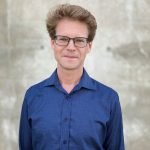Part III: Creating The Internet of Sound with Nils Peters.
In June 2020, Dr. Nils Peters joined the International Audio Laboratories Erlangen as Associate Professor. His group conducts research in “Audio Signal Processing for the Internet of Things.”
By 2030, more than 25 billion devices are expected to communicate and exchange information with each other. Dr. Peters knows the Internet of Things (IoT) is opening new application areas. Together with the experts at Fraunhofer IIS, he researches the possibilities of audio applications in IoT. In this context, his focus is on the Internet of Sound (IoS).
For example, connected devices offer numerous possibilities in the field of music. Band members can rehearse their songs even if they are physically separated from one another. At virtual concerts, the mood of the audience can be sensed and captured, allowing artists real-time feedback to adapt their setlist to changing moods. Other areas of application include music production and music education. Future apps and smart instruments make it possible to precisely analyze errors during practice sessions and thus improve on them. To ensure personalized user experiences, it is essential that the audio quality of such applications is high and latency is low, as the experts at Fraunhofer IIS know.
The IoS transmits audio and related data that humans and machines create and consume. Here, Prof. Peters’ research work currently focuses on several areas, such as data security and user privacy, efficient algorithms for small edge devices, and distributed algorithms for several types of devices working in and with the cloud. Examples include sensor networks, like microphone arrays, that enable spatially aware acoustic event detection applications. Since many devices, such as smartphones, already have audio recording and playback capabilities, the advantages to forming IoS networks with this wide availability of devices are efficient application costs. Microphones are cheaper to manufacture and operate than other sensors, such as cameras.
To create a powerful, distributed microphone array IoS application, connecting different types of devices into one network and efficiently exchanging the relevant acoustic data quickly, is challenging. A smartphone could outsource the processing of a complex task to a near data center and receive the result back in the shortest possible time. This would be very practical – but would it be secure, too? The more complex the networks and the more distributed the computing power, the more difficult it becomes to ensure privacy and security.

Clearly, the IoS offers numerous possibilities and open questions for research that Prof. Peters investigates with his team. He has always enjoyed exploring complex, interdisciplinary topics. His amassed experience and knowledge in Austria, Canada, and the U.S. includes room acoustics, psychoacoustics, signal processing, and machine learning. He graduated with a Masters of Science in electrical engineering and audio engineering at the University of Music and Performing Arts Graz and the Graz University of Technology. He earned a PhD in Music Technology from McGill University, Montreal, where he studied spatial auditory perception and developed spatial audio rendering tools to improve the audience’s listening experience under the supervision of Prof. Stephen McAdams in the Music Perception and Cognition Lab (MPCL). He then conducted post-doctoral research at the International Computer Science Institute (ICSI), the Center for New Music and Audio Technologies (CNMAT) and the Parallel Computing Laboratory at the University of California, Berkeley. His focus was on the technical capabilities and applications for multichannel audio processing for a 144-channel microphone array. Before joining the AudioLabs, Prof. Peters worked for Qualcomm, Inc., in San Diego and developed algorithms for spatial audio scene analysis and 3D audio coding. Some of these algorithms were integrated into the MPEG-H 3D Audio ISO standard.
Prof. Peters enjoys sharing his extensive international and interdisciplinary expertise and encouraging students to explore audio signal processing through a scientific and creative lens. As co-chair of the Audio Engineering Society’s Spatial Audio Technical Committee since 2013, he facilitated founding the AES Student Section Erlangen-Nürnberg and serves as their faculty advisor.

